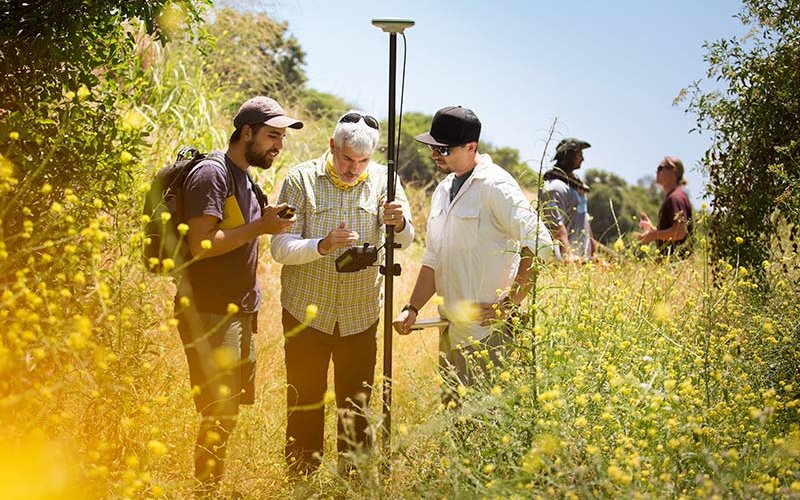
Hollywood depicted “The Big One” devastating the San Francisco Bay Area and Los Angeles — California’s most populated regions — in a multimillion-dollar feature film. Such a mighty earthquake along the San Andreas Fault could strike in our lifetime, says earthquake scientist Sinan Akçiz.
The estimated 15- to 20-million-year-old San Andreas Fault, especially the southern section near Orange and Los Angeles counties, is capable of producing an earthquake that can cause strong seismic shaking. “It’s not a matter of if, but when,” Akçiz points out.
While California prepares for the next big seismic force, Cal State Fullerton experts are shaking things up in earthquake research. Over the last decade, Akçiz has been searching for clues of the next temblor, digging into the past to find evidence of large earthquakes along the Southern California section of the San Andreas Fault. Collaborative research with his students, as well as geologists from UC Irvine and Arizona State University, could better explain the geological complexity of the 800-mile fault system, which crisscrosses through the San Francisco area in the north to the Southland and across the Mexican border.
Akçiz started his earthquake research in 2005 within Kern County’s Carrizo Plain National Monument. He was part of a research team that discovered evidence of at least six major surface-rupturing quakes over the last 700 years on the southern section of the fault system. The earliest temblor occurred in the 1350s, with the last one on Jan. 9, 1857, when a 7.9-magnitude temblor ruptured a 250-mile section of the fault between Monterey County’s Parkfield — dubbed the “Earthquake Capital of the World” — and Wrightwood.
The study found that earthquakes occurred in 100-year intervals on the fault’s southern section and not every 250 to 400 years, as researchers previously thought, signaling a warning for a major quake in Southern California.
“We now know that this section poses a significant seismic hazard and is a major threat to the health and safety of Californians. It’s a great reminder that we live in earthquake country,” notes Akçiz, assistant professor of geological sciences, who was the lead author of a journal paper in Geology that describes the discovery.
The paleoseismologist studies the times and magnitudes of past earthquakes along fault systems, especially those in populated areas. His research takes place inside the natural laboratory of 12-foot deep, 3-foot wide trenches along the San Andreas Fault, which extends to depths of more than 30,000 feet. Akçiz’s recent research sites are mostly within Carrizo Plain, about 200 miles northwest from Cal State Fullerton, near the aptly named Temblor Range.
Earlier this summer, Akçiz and his students spent a month at Carrizo Plain, hand-digging in the dirt and in 100-degree heat. Through their work, the researchers are looking for a pattern of large quakes that ruptured the region. Inside the trenches, the research team collected data to further study and document the earth’s sediment layers, looking for what the soil reveals about the area’s history of earthquakes.
“It’s grueling work in the field,” he tells. “But it’s important, especially if we can expand the earthquake record, and then we might be able to see what the future looks like with more accurate forecasts of earthquakes.”
Such collaborative research, Akçiz adds, can benefit society in a number of ways, including improving infrastructure to prevent the collapse of buildings, highways and dams.
His CSUF colleague, earthquake engineer Kristijan Kolozvari, agrees. He and his students are researching ways to improve the seismic performance of tall buildings to withstand a destructive collapse in the event of a major quake.
Kolozvari’s research focuses on developing innovative simulation tools to predict the seismic performance of skyscrapers as tall as 40 to 60 stories — including buildings currently being designed or under construction in downtown Los Angeles — following a strong earthquake. Last year, the assistant professor of civil and environmental engineering received National Science Foundation funding for his work with Cal State Long Beach engineering colleagues.
“Current methodologies for the design of tall buildings are focused on preventing loss of human lives, which is essential. But these methodologies do not take into account the amount of damage, the repair cost and the time that buildings are out of function,” says Kolozvari.
Using computer models, the researchers are examining the interaction between soil, foundation, structural and nonstructural building components to provide a methodology for identifying engineering design requirements to boost building resiliency, he explains.
Kolozvari has studied the structural design of buildings in seismic-prone regions across the globe, including Japan, which was hit by a 9.1-magnitude earthquake in 2011.
“We hope to develop a framework that will shed new light on current design approaches and lay out new design procedures that will enable engineers to design buildings that will be in function shortly after the earthquake, and therefore minimize the impact of earthquakes on society, which is the main objective of earthquake resiliency,” he adds. “Above all, I’m interested in the field because it helps to build safer structures and protect people’s lives in earthquakes.”
The Titan experts agree that in addition to research, everyone needs to prepare for a massive earthquake.
“At a minimum, store some extra water that will last for about a week, and prepare yourself and your family accordingly,” Akçiz says. “Everybody asks when the next ‘Big One’ is going to happen and we can’t tell you. There is no crystal ball. What we do know is that it can happen anytime.”